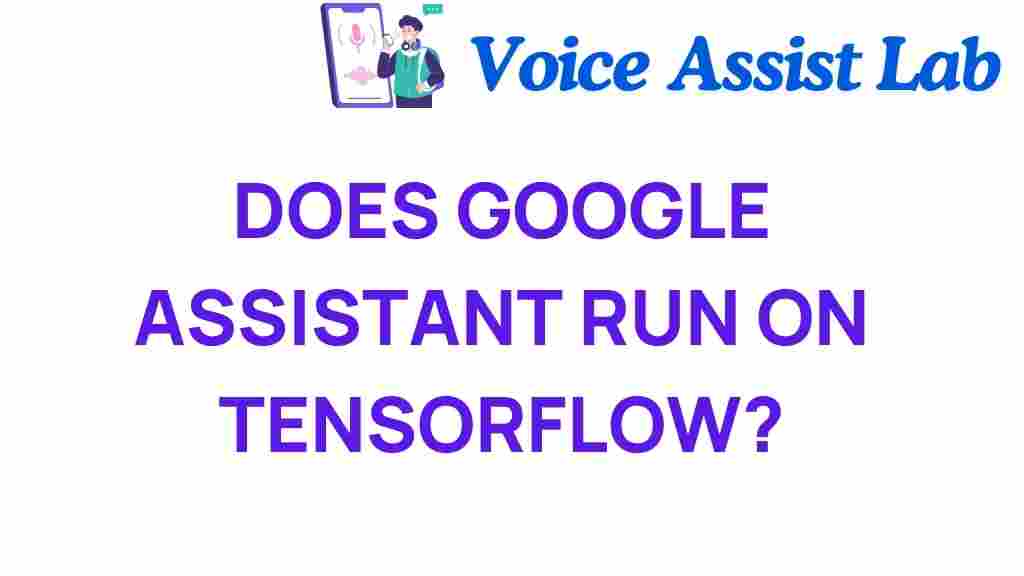Unveiling the Secrets: Does Google Assistant Run on TensorFlow?
In the world of smart devices and AI, Google Assistant stands out as a leading voice recognition technology. But have you ever wondered what powers this innovative software? One of the key elements behind the capabilities of Google Assistant is TensorFlow, a powerful machine learning framework developed by Google. In this article, we will explore the relationship between Google Assistant and TensorFlow, diving into the mechanics of how these technologies work together to provide a seamless user experience.
Understanding Google Assistant and TensorFlow
Before we delve into the specifics, let’s define what Google Assistant and TensorFlow are:
- Google Assistant: An AI-powered virtual assistant that can perform tasks, answer questions, and control smart devices through voice commands.
- TensorFlow: An open-source machine learning framework that allows developers to create and train models for various AI applications, including speech recognition, image processing, and more.
The integration of TensorFlow into Google Assistant enhances its voice recognition capabilities, enabling it to understand and respond to user commands effectively. The synergy between these technologies is a prime example of how innovation in technology can improve our everyday interactions with devices.
How Google Assistant Uses TensorFlow
Google Assistant leverages TensorFlow for various functions, particularly in the realm of machine learning. Here’s a step-by-step breakdown of how this integration works:
- Data Collection: Google Assistant collects vast amounts of voice data from users to improve its recognition capabilities.
- Model Training: TensorFlow allows Google’s engineers to create complex machine learning models that can learn from this data. They can train these models to recognize different accents, dialects, and speech patterns.
- Real-Time Processing: When a user speaks to Google Assistant, the voice is processed in real-time using TensorFlow models to convert speech into text.
- Intent Recognition: Once the speech is transcribed, TensorFlow is used to analyze the text and determine the user’s intent, whether it’s to turn on a light or check the weather.
- Response Generation: Finally, Google Assistant formulates a response, which is spoken back to the user, completing the interaction.
This workflow showcases how Google Assistant harnesses the power of TensorFlow to enhance user experience and functionality.
The Importance of Machine Learning in Voice Recognition
Machine learning is the backbone of modern voice recognition technologies, including Google Assistant. Here are some reasons why:
- Accuracy: Machine learning algorithms improve the accuracy of voice recognition systems by learning from previous interactions.
- Adaptability: Google Assistant can adapt to individual users over time, becoming more attuned to their specific speech patterns and preferences.
- Natural Language Processing (NLP): TensorFlow enables Google Assistant to utilize NLP, allowing it to understand context and nuances in human language.
These advancements in AI and machine learning are crucial for making Google Assistant a reliable and efficient virtual assistant.
Innovations Behind Google Assistant
Google Assistant’s capabilities are not just limited to voice recognition. Several innovations powered by TensorFlow contribute to its overall functionality:
- Contextual Awareness: Google Assistant can remember context from previous interactions, enabling more fluid conversations with users.
- Multimodal Interaction: Beyond voice, Google Assistant can interact through text and visuals, making it versatile across different devices.
- Personalization: With machine learning, Google Assistant can provide personalized recommendations based on user preferences and behaviors.
These innovations make Google Assistant a comprehensive tool that integrates seamlessly with various smart devices.
Step-by-Step Process: Enabling Google Assistant on Your Device
Now that we understand the technology behind Google Assistant, let’s look at how to enable it on your device:
- Check Compatibility: Ensure your device supports Google Assistant. Most Android smartphones and Google Home devices do.
- Download the Google App: If you don’t have it, download the Google app from the Google Play Store or Apple App Store.
- Open Google Assistant: On your device, open the Google app and tap on the microphone icon or say “Hey Google.”
- Set Up Voice Match: Follow the prompts to set up Voice Match, allowing Google Assistant to recognize your voice.
- Customize Settings: Go to settings to customize Google Assistant’s preferences, including language and voice options.
With these simple steps, you can harness the power of Google Assistant powered by TensorFlow.
Troubleshooting Common Issues with Google Assistant
Sometimes, users may encounter issues while using Google Assistant. Here are some common problems and how to troubleshoot them:
- Google Assistant Not Responding: Ensure the microphone is not muted and check your internet connection.
- Poor Voice Recognition: Try retraining Voice Match by going into the settings and following the prompts.
- Inaccurate Responses: Provide feedback by saying “That’s not what I meant,” which helps improve the model over time.
By following these troubleshooting tips, you can enhance your experience with Google Assistant.
The Future of Voice Recognition Technology
The future of voice recognition technology, powered by innovations like TensorFlow, looks promising. Here are some trends to watch:
- Improved Natural Language Understanding: Future advancements will make it easier for AI to understand complex queries and respond appropriately.
- Integration with More Devices: As smart devices proliferate, Google Assistant will likely be integrated with even more home and office technology.
- Enhanced Personalization: Expect even greater personalization features that adapt to user behavior and preferences.
These advancements will continue to improve how we interact with technology and utilize services like Google Assistant.
Conclusion
In conclusion, Google Assistant is a remarkable example of how technology and innovation in AI and machine learning are transforming our interactions with smart devices. The integration of TensorFlow plays a crucial role in enabling accurate voice recognition and improving the user experience. As this technology continues to evolve, we can expect even more impressive capabilities from Google Assistant and similar platforms.
For more insights on how voice recognition technology is shaping our future, check out this informative article. To explore more about the capabilities of Google Assistant, visit the official Google Assistant page.
This article is in the category Innovations and created by VoiceAssistLab Team
